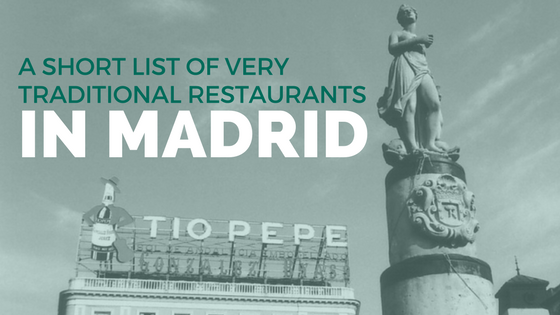A SHORT LIST OF VERY TRADITIONAL RESTAURANTS IN MADRID

The author of this post is Cecilia Prieto, a journalist born in the north of Spain that has been living in Madrid since 2009. She currently writes and edits Madlocal, a blog devoted to tourism in Madrid, with a focus on insights to enjoying Madrid as the locals do. Enjoy her list of traditional restaurants in Madrid!
Hi, Madlocals! Today I want to share with you some tips that will definitely give you a next-level experience in Madrid. And, lucky for you, all of them are related to delicious Spanish food.
First, I want to teach you something very important about the Spanish culture: food is not only for feeding yourself. In this country, food is a very important cultural feature. It is related with the sense of community, because food is meant as an excuse to meet with people and have a good time. It’s a bit of a ceremony or ritual because every course must be respected: starter, entree, and dessert. For example, in Spain it’s considered to be quite strange to order a coffee while you are eating. You must wait until the very end to enjoy it with your dessert! Finally, eating in Spain is a way to break up the day, because food is supposed to be enjoyed, even if you only have a 30-minute break at your office. In Spain, nothing is as sad as eating a sandwich in front of your computer!
As you may know, there are many exquisite restaurants in Madrid. We also have the oldest restaurant in the world, Sobrinos de Botín. It’s so old that painter Francisco de Goya used to work there as a waiter when he was young. The only drawback is that this restaurant is usually pretty crowded, especially with tourists. If you want to get a more local experience, you may want to take a look at this short list of very traditional restaurants in Madrid.
Casa Ciriaco
King Alfonso XIII married princess Victoria Eugenia on May 31, 1906. An anarchist threw a bomb at their carriage, causing 25 deaths and a hundred injuries, including the king. Casa Ciriaco had already opened for the day, and the king was taken in to be attended to by a doctor. There are pictures from that day decorating its walls in the hall, but the dining area behind has more lively decor with plenty of pictures of old Spanish stars.
#Madridhack: If you don’t speak fluent Spanish, bring a dictionary with you. You’re going to need it!
Bodega La Ardosa
This place is even older as it has been open since 1892. Located in the hipster neighborhood of Malasaña, this old tavern takes you on a trip back in time, including the traditional Spanish dishes that have been passed down for generations. They serve one of the best tortillas in Madrid, but the croquetas and salmorejo are also fantastic choices as well.
#Madridhack: Look at the walls to discover the tavern’s drinking contest. Winning results are hilarious (and also a bit worrying!).
#Madridhack: After a fine lunch or dinner, you can go to La Bicicleta or La Realidad (two minutes away on foot) and order a gin and tonic to elevate your experience.
See more: Our 5 Favorite Places to Eat Tortilla Española in Madrid
La Castela
This restaurant has been famous for many years for its traditional style and its specialty in fish and seafood. Since 2016, it has been especially famous because since the visit of Michelle Obama (rumors say the food really pleased her!). I must say this is one of my top restaurants in Madrid as everything on the menu is truly delicious! My recommendations include: boletus (mushrooms), chickpeas with prawns, octopus & squid rice, hake, cod, turbot or sirloin, if meat is more to your liking.
Cocido Madrileño: an introduction
Last but not least, I want to talk about a life-changing meal which is very typical from Madrid, cocido madrileño. It even has a song! Chickpeas perform the leading role in this meal, which also include other vegetables, meat and chorizo.
Cocido madrileño is traditionally served in two ways: with all ingredients together, or separated in three phases, which is the most popular way. Soup is served as the first course. It’s made from chickpeas and has noodles with it, and sometimes is served with some chicken, too. True traditional restaurants will serve it in a tureen or directly in the pot where it has been cooked, and portions are generous, so each guest can have as much soup as they want.
The second course is what I like to call “the vegan option”, because it’s a big plate with chickpeas, carrots and potatoes, all of them boiled (cocido literally means “boiled,” so that’s the essence of this meal). It might also have cabbage, turnips and/or leek.
Then, the third course is served straight after as it is meant to be mixed with the second one. This is the “meat lovers” part of cocido: it has jamón, chorizo, chicken, veal, black pudding, fat and even marrow.
There’s a place in Madrid that is considered to be the best spot to get cocido madrileño. It’s called Casa Carola and it only serves cocido. Don’t go with anybody that might not like cocido because there’s nothing else at the kitchen! If you want something less radical, you can also choose La Daniela. There are four restaurants under this name which serve a very good cocido and have more options on their menu.
I hope you find all these tips to be useful. Let’s enjoy Madrid as locals!
